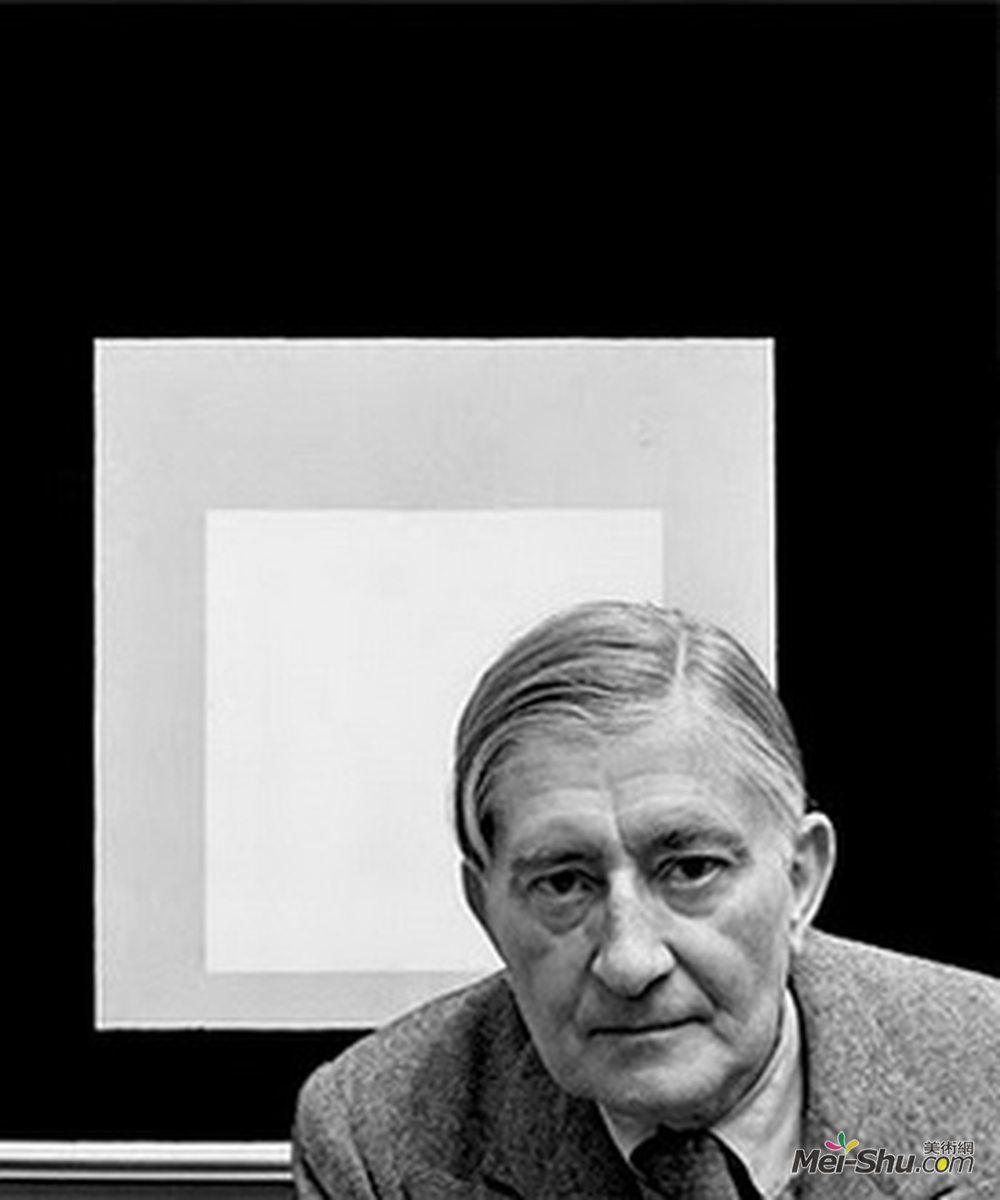
约瑟夫·亚伯斯(Josef Albers)
艺术家: 约瑟夫·亚伯斯
生于: 1888年3月19日;波特罗普,德国
卒于: 1976年3月25日;纽黑文,美国
国籍: 德国
流派: 建构主义,具体艺术
领域: 绘画,版画,设计,摄影
受影响: 皮特·蒙德里安,威斯利·康定斯基,卡西米尔·马列维奇,Bauhaus,Suprematism,Futurism,Constructivism,Expressionism
影响: Ad Reinhardt,Kuno Gonschior
朋友: 保罗·克利
机构: 慕尼黑(慕尼黑美术学院学院,慕尼黑,德国)
约瑟夫·阿尔伯斯是美国出生于德国的艺术家和教育家,在欧洲和美国的作品构成了20世纪一些最具影响力和影响深远的艺术教育计划的基础。学生在约翰·伊顿的基础课上享有盛名的Weimar Bauhaus 1920。包豪斯美术馆的馆长和创办人沃尔特·格罗皮乌斯于1923年请他在设计系的“Werklehre'”初级课程中教授手工艺原理。1925,阿尔伯斯被提升为教授,包豪斯搬到德绍的那一年。此时,他嫁给了Anni Albers(N& & P;233;e Fleischmann),他也是那里的一名学生。他在德绍的工作包括设计家具和使用玻璃。作为一个年轻的美术老师,他在包豪斯教Oskar Schlemmer、Wassily Kandinsky和保罗·克利等艺术家。Klee是所谓的班主任,在Albers是手工艺大师的玻璃车间里教正式方面的知识,他们合作了几年。
随着包豪斯在1933年纳粹的压力下关闭,Albers移居美国;在1933年11月,他加入了fa。布莱克山学院,北卡罗莱纳,在那里他运行绘画程序,直到1949。在黑山,他的学生包括罗伯特·劳森伯格、CY TouMLBLY、Ray Johnson和Susan Weil。他还邀请重要的美国艺术家威廉·德·库宁,在夏季研讨会上授课。Weil说,作为一名教师,Albers是&他自己的学院&并且说,Albers声称当你在学校的时候,你不是艺术家,你是学生"1950年,阿尔伯斯离开黑山,在康涅狄格州纽黑文的耶鲁大学担任设计系主任。1962,作为耶鲁大学的一名研究员,他从格雷厄姆基金会获得了一份关于他的作品的展览和讲座。Albers还与耶鲁大学教授和建筑师King-lui Wu合作,为Wu'的一些项目创作了装饰性设计。其中有鲁斯(1954)和杜邦(1959)房屋的独特几何壁炉,手稿学会的正面,耶鲁&滦的秘密高级团体之一(1962),以及贝塞尔山浸礼堂(1973)的设计。同时,他在他的结构星座作品。1963年,他出版了《颜色的相互作用》,该书提出了他的理论,即颜色是由一种内在的、欺骗性的逻辑控制的。在这段时间里,他创造了乐队领袖EnoCH Loopy&Sufl 39的唱片集。1973,他当选为美国文理学院院士。阿尔伯斯继续绘画和写作,与妻子,纺织艺术家安妮·阿尔伯斯住在纽黑文,直到1976年去世。
作为一名设计师、摄影师、印刷师、版画家和诗人,阿尔伯斯以其抽象画家和理论家的作品而闻名。他偏爱纪律严明的写作方法。最著名的是数以百计的绘画和版画,构成了对广场的一系列敬意。在1949开始的这个严格的系列中,阿尔伯斯探索了嵌套正方形的色相互作用。
Artist :Josef Albers
Additional Name :Josef Albers
Born : Bottrop, Germany
Died : New Haven, United States
Nationality :German
Art Movement :Constructivism,Concrete Art (Concretism)
Field :painting,printmaking,design,photography
Influenced by :piet-mondrian,wassily-kandinsky,kazimir-malevich,artists-by-painting-school/bauhaus,artists-by-art-movement/suprematism,artists-by-art-movement/futurism,artists-by-art-movement/constructivism,artists-by-art-movement/expressionism
Influenced on :ad-reinhardt,kuno-gonschior
Friends and Co-workers :paul-klee
Art institution :Akademie der Bildenden Künste München (Munich Academy), Munich, Germany
Josef Albers was a German-born American artist and educator whose work, both in Europe and in the United States, formed the basis of some of the most influential and far-reaching art education programs of the 20th century.
He studied art in Berlin, Essen, and Munich, before enrolling as a student in the basic course of Johannes Itten at the prestigious Weimar Bauhaus in 1920. The director and founder of the Bauhaus, Walter Gropius, asked him in 1923 to teach in the preliminary course ‘Werklehre' of the Department of Design to introduce newcomers to the principles of handicrafts. In 1925, Albers was promoted to Professor, the year the Bauhaus moved to Dessau. At this time, he married Anni Albers (née Fleischmann) who was also a student there. His work in Dessau included designing furniture and working with glass. As a younger art teacher, he was teaching at the Bauhaus with artists including Oskar Schlemmer, Wassily Kandinsky and Paul Klee. Klee was the so-called form master who taught the formal aspects in the glass workshops where Albers was the crafts master; they cooperated for several years.
With the closure of the Bauhaus under Nazi pressure in 1933, Albers emigrated to the United States; in November 1933, he joined the faculty of Black Mountain College, North Carolina, where he ran the painting program until 1949. At Black Mountain, his students included Robert Rauschenberg, Cy Twombly, Ray Johnson and Susan Weil. He also invited important American artists as Willem de Kooning, to teach in the summer seminar. Weil remarked that, as a teacher, Albers was "his own academy" and said that Albers claimed that "when you’re in school, you’re not an artist, you’re a student", though he was very supportive of self-expression when one became an artist and began his or her journey.
In 1950, Albers left Black Mountain to head the Department of Design at Yale University in New Haven, Connecticut. In 1962, as a fellow at Yale, he received a grant from the Graham Foundation for an exhibit and lecture on his work. Albers also collaborated with Yale professor and architect King-lui Wu in creating decorative designs for some of Wu's projects. Among these were distinctive geometric fireplaces for the Rouse (1954) and DuPont (1959) houses, the façade of Manuscript Society, one of Yale's secret senior groups (1962), and a design for the Mt. Bethel Baptist Church (1973). Also, at this time he worked on his structural constellation pieces. In 1963, he published Interaction of Color which presented his theory that colors were governed by an internal and deceptive logic. Also during this time, he created the abstract album covers of band leader Enoch Light's Command LP records. He was elected a Fellow of the American Academy of Arts and Sciences in 1973. Albers continued to paint and write, staying in New Haven with his wife, textile artist Anni Albers, until his death in 1976.
Accomplished as a designer, photographer, typographer, printmaker and poet, Albers is best remembered for his work as an abstract painter and theorist. He favored a very disciplined approach to composition. Most famous of all are the hundreds of paintings and prints that make up the series Homage to the Square. In this rigorous series, begun in 1949, Albers explored chromatic interactions with nested squares.